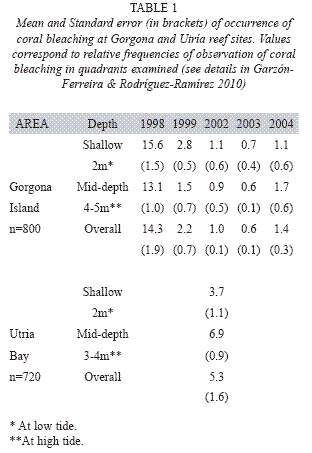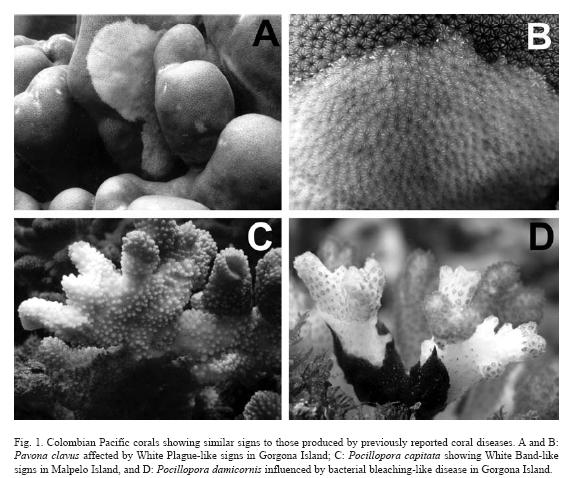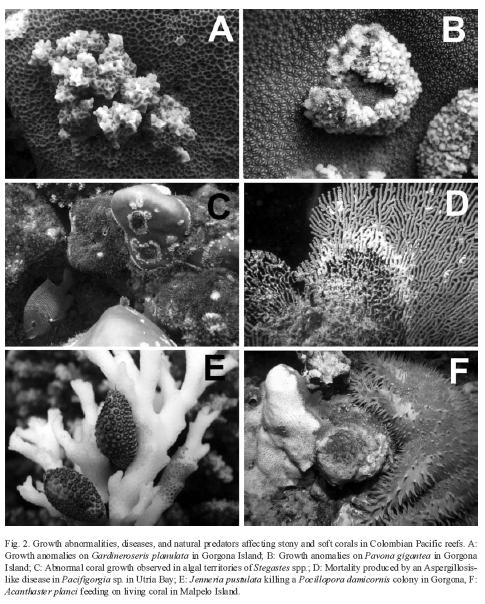Services on Demand
Journal
Article
Indicators
-
 Cited by SciELO
Cited by SciELO -
 Access statistics
Access statistics
Related links
-
 Similars in
SciELO
Similars in
SciELO  uBio
uBio
Share
Revista de Biología Tropical
On-line version ISSN 0034-7744Print version ISSN 0034-7744
Rev. biol. trop vol.58 suppl.1 San José May. 2010
Agents of coral mortality on reef formations of the Colombian Pacific
Raúl Navas-Camacho, Alberto Rodríguez-Ramírez & María Catalina Reyes-Nivia
Instituto de Investigaciones Marinas y Costeras, INVEMAR, Punta de Betín, Zona Portuaria, Santa Marta, Colombia; rnavas@invemar.org.co, betorod@invemar.org.co, catareyes@invemar.org.co
Dirección de correspondencia
Abstract
The National Monitoring System for Coral Reefs of Colombia (SIMAC) monitors the impact of some of the most important agents of coral tissue loss (bleaching and/or disease) in the Colombian Pacific coral formations since 1998. Physiological bleaching is among the main results of stress in the area. Signs of coral diseases resembling bacterial bleaching such as White Plague and White Band, were observed in Malpelo and Gorgona islands. Damage to the Pacific gorgonian Pacifigorgia spp., similar to those produced by Aspergillosis in Caribbean corals, was detected in Utría Bay. The presence of tumors in colonies of massive corals was also recorded. Even though coral diseases are globally widespread, their occurrence in American Pacific reefs has been poorly documented to date. Rev. Biol. Trop. 58 (Suppl. 1): 133-138. Epub 2010 May 01.
Key words: Coral diseases, coral bleaching, monitoring, SIMAC, Colombian Pacific.
Resumen
Palabras clave: Enfermedades coralinas, blanqueamiento, monitoreo, SIMAC, Pacífico colombiano.
It is believed that coral bleaching and coral diseases are responsible for most of the damage that coral reefs are experiencing around the world (Brown 1997, Richardson 1998, Green & Bruckner 2000, Baird & Marshall 2002, Rosenberg & Ben-Haim 2002, Douglas 2003, Rosenberg & Loya 2004, Sutherland et al. 2004). Colombian coral reefs have not been exempt of these phenomena, where records of bleaching events in the Colombian Pacific (Prahl 1983, 1985; Vargas-Ángel et al. 2001), and coral disease outbreaks in the Caribbean (Garzón-Ferreira et al. 2001) have been reported since the last 20 years. The most dramatic bleaching events have been associated with El Niño Southern Oscillation (ENSO), particularly during the 1982-1983 and 1997-1998 events (Prahl 1983, 1985, Vargas-Ángel et al. 2001), although, the importance of other events such as sediment discharges, extreme low tides, and anthropogenic influences are also recognized as prompters of coral bleaching in the area (Zapata et al. 2001). The National Monitoring System for Coral Reefs of Colombia-SIMAC- currently assesses three Pacific coral reef areas: Gorgona Island, Utría Bay, and Malpelo Island. Detailed information on these areas and their monitoring protocol may be found in Garzón-Ferreira & Rodríguez-Ramírez (2010). In November 1998, at the end of the 1997-1998 ENSO event, the SIMAC monitoring protocol was applied for the first time in Gorgona island, finding that 14.3%±1.9 of the quadrants examined showed signs of bleaching (Table 1), mainly at the shallower sites (1 to 3m) with 15.6%±1.5 (Table 1). These data can be supported by the information reported by Vargas-Ángel et al. (2001) with a bleaching average of 24% in the evaluated area, and that Pocillopora damicornis was the most affected species by the anomaly created by the ENSO. After 1999, the incidence of bleaching decreased to 2.2%±0.7, and it remained low until 2004 (Table 1). This event shows the particular resistance of Pocilloporid corals and their regeneration capabilities to catastrophic events in Gorgona island. Among the coral species reported for the area, bleaching resulted more frequent in the genus Pocillopora, particularly in P. damicornis and P. capitata, species that dominate the reefs in this island (Zapata 2001). Lower levels of incidence were observed in Pavona gigantea and Psammocora stellata. The bleaching incidence in Utría during 2002 (5.3%±1.6) and Malpelo in 2003 (2.3%±1.8) was relatively low, with the highest values in the mid-depth sites in Utría Bay (6.9%±0.9) (Table 1). As in Gorgona island, the most frequently affected species were the branching corals of the genus Pocillopora.
Regarding coral diseases in the Colombian Pacific, there is not definitive proof of their presence in the area. The first report of signs of coral disease was in Malpelo by Garzón-Ferreira & Pinzón (1999), who observed coral tissue degradation similar to the one produced by White Band Disease or White Plague Disease. Later observations performed during SIMAC monitoring, revealed the possible presence of these diseases in the Colombian Pacific reefs. During the 2003 and 2004 Gorgona assessments, similar signs to the ones produced by White Plague Disease were found on massive Pavona gigantea corals in belt transect quadrats and during rover-diving. We observed a defined thin white line that divides live tissue from necrotic areas; bared skeleton showed the presence of filamentous algae (Fig. 1 A and B). This is similar to the descriptions of White Plague, a coral disease widely spread throughout the Caribbean, that has been also observed in other areas such as the Red Sea and the Indopacific (Green & Bruckner 2000, Sutherland et al. 2004).
During the 2003 Malpelo assessment, corals of the genus Pocillopora spp. were observed with similar signs to those of the Caribbean White Band Disease. Fig. 1 C shows a white band on coral branches that apparently progresses toward the top of the branches, leaving the bare skeleton on the bases, which are subsequently colonized by algae. These corals were found outside the permanent belt transects during rover diving assessments. Also in 2003, Pocillopora spp. corals with signs resembling those of Bacterial Bleaching were found in Gorgona island. This disease has been found infecting P. damicornis in the Indo-Pacific and it is produced by Vibrio coralliilyticus, bacteria found in different parts of the world (Ben-Haim & Rosenberg 2002, Ben-Haim et al. 2003a). Fig. 1 D shows coral colonies with small patches of healthy tissue on the branches tips, surrounded by an area of white skeleton deprived of living polyps; the basal area was covered by cyanobacteria that colonized the available area left. Ben-Haim et al. (2003 a, b) showed that this disease is highly virulent when water temperature is higher than 27oC.
In 2003 and 2004, abnormal skeletal tissue proliferations similar to hyperplasia reported by Peters (1984), Loya et al. (1984) and Gateño et al. (2003), were found in Pavona gigantea and Gardineroseris planulata (Fig. 2 A and B) in Gorgona island. These tumors grew perpendicularly to the main vertical axis of colony growth, as thickened skeletal tissue, usually colorless. In some cases, evidence of tissue death was observed; in others, the abnormal growth corresponded to coral response against stress produced by algal territories of Stegastes spp. (Fig. 2 C). In Utría, colonies of the gorgonian coral Pacifigorgia sp. (Fig. 2 D) exhibited similar tissue lesions to the ones produced by Aspergillosis in Caribbean octocorals (J. Garzón-Ferreira, pers. comm., Smith et al. 1996).
An abiotic stress factor that causes bleaching and even death in the Colombian Pacific corals is subaereal exposure during extreme low tides (Zapata et al. 2001). The Colombian Pacific coast exhibits a tidal range of up to 5m (IDEAM 2000, Díaz et al. 2001). During periods of extreme low tides, it is usual to observe extense areas of reefs exposed, which under intense solar radiation, result in bleaching or even death of coral colonies. Consequences of long-lasting and repeated aereal exposures can be seen in shallow areas of coral formations at Gorgona, where large areas of dead coralare completely covered by turf algae (Zapata et al. 2001).
Another important cause of coral tissue loss found in Colombian Pacific reefs is predation. The gastropod Jenneria pustulata (Fig. 2 E) is commonly found in Utría and Gorgona reefs, especially between branches of Pocillopora spp. Lesions caused by this gastropod look similar to those of White Band Disease, leaving a white band of bare skeleton separated of the living tissue by a clearly defined thin line. Additionally, predation on corals by the crown-of-thorns starfish (Acanthaster planci) was observed in reefs of Malpelo (Narváez & Zapata 2010) (Fig. 2 F). This echinoderm removes the coral tissue from the skeleton in relatively short time causing lesions that might also resemble those caused by White Band Disease on branching corals and White Plague Disease on massive corals in the Caribbean. Because lesions caused by some coral diseases are similar to those caused by coral predators, it is important to establish whether some of the lesions described here are the product of previously described coral diseases or are produced by predators. Clearly, further research is necessary to confirm the presence of coral diseases in the tropical American Pacific. Furthermore, it is essential to obtain quantitative data on coral mortality caused by the agents described here to establish the role that they are playing in the dynamics of coral communities on these reefs.
Acknowlegments
This work was carried out with the financial support of FONAM (Convenio Programa Ambiental BID-7740C/CO) and the Colombian Institute for Marine and Coastal Research INVEMAR. Field work was supported by the Colombian Institute for the Development of Science and Technology-COLCIENCIAS-(Proyecto Colciencias-BID 2105-09-327-97), INVEMAR and UNEP-CAR/RCU, the National Park System Especial Administrative Unit (UAESPNN), Universidad del Valle, and the Colombian National Navy. We acknowledge Jaime Garzón-Ferreira and Diego L. Gil-Agudelo of INVEMAR and, Fernando A. Zapata and the Coral Reef Ecology Research Group at Universidad del Valle, Sonia Bejarano, Mateo López and Camilo Gómez for their help during field work at Gorgona Island, and the commanders and crew of the ARC Malpelo and ARC Providencia Oceanographic Vessels, and Fundación Malpelo for their logistic support. Contribution No. CTBR-1041 from INVEMAR.
References
Baird, A.H. & P.A. Marshall. 2002. Mortality, growth and reproduction in scleractinian coral following bleaching on the Great Barrier Reef. Mar. Ecol. Prog. Ser. 237: 133-141. [ Links ]
Ben-Haim, Y. & E. Rosenberg. 2002. A novel Vibrio sp. pathogen of coral Pocillopora damicornis. Mar. Biol. 141: 47-55. [ Links ]
Ben-Haim, Y., F.L. Thompson, C.C. Thompson, M. C. Cnockaert, B.Hoste, J. Swings & E. Rosenberg. 2003a. Vibrio coralliityticus sp. nov., a temperature-dependent pathogen of the coral Pocillopora damicornis. Int. J Syst. Evol. Microbiol. 53: 309-315. [ Links ]
Ben-Haim, Y., M. Zicherman-Keren & E. Rosenberg. 2003b. Temperature-regulated bleaching and lysis of the coral Pocillopora damicornis by the novel pathogen Vibrio corralliilyticus. Appl. Environ. Microbiol. 69: 4236-4242. [ Links ]
Brown, B. 1997. Coral bleaching: causes and consequences. Proc. 8th Int. Coral Reef Symposium 1: 65-74. [ Links ]
Douglas, A.E. 2003. Coral bleaching-How and Why? Mar. Poll. Bull. 46: 385-392. [ Links ]
Díaz, J.M., J.H. Pinzón, A.M. Perdomo, L.M. Barrios & M. López-Victoria. 2001. Generalidades. p.17-26. In Barrios, L.M & M. López-Victoria (Eds). Gorgona marina: Contribución al conocimiento de una isla única. INVEMAR. Serie Publicaciones Especiales No. 7, Santa Marta, Colombia. [ Links ]
Gateño, D., A. León, Y. Barki, J. Cortés & B. Rinkevich. 2003. Skeletal tumor formations in the massive coral Pavona clavus. Mar. Ecol. Prog. Ser. 258: 97-108. [ Links ]
Garzón-Ferreira, J. & A. Rodríguez-Ramírez. 2010. SIMAC: Development and implementation of a coral reef monitoring network in Colombia. Rev. Biol. Trop. 58 (Suppl. 1): 67-80. [ Links ]
Garzón-Ferreira, J. & J. H. Pinzón. 1999. Evaluación rápida de estructura y salud de las formaciones coralinas de la Isla de Malpelo (Pacífico colombiano). Bol. Invest. Mar. Cost. 28: 137-154. [ Links ]
Garzón-Ferreira, J., D.L. Gil-Agudelo, L.M. Barrios & S. Zea. 2001. Stony coral diseases observed in Southwestern Caribbean reefs. Hydrobiologia 460: 65-69. [ Links ]
Green, E.P. & A.W. Bruckner. 2000. The significance of coral disease epizootiology for coral reef conservation. Biol. Conserv. 96: 347-361. [ Links ]
IDEAM, 2000. Pronóstico de pleamares y bajamares en la costa Pacífica colombiana para el año 2000. Instituto de Asuntos Ambientales, Bogotá, Colombia. [ Links ]
Loya, Y., G. Bull & M. Pichon. 1984. Tumor formations in scleractinian corals. Helgoländer Meeresun. 37: 99-112. [ Links ]
Narváez, K. & F. Zapata. 2010. First record and impact of the crown-of-thorns starfish, Acanthaster planci (Spinulosida: Acanthasteridae) on corals of Malpelo Island, Colombian Pacific. Rev. Biol. Trop. 58 (Suppl. 1): 139-143. [ Links ]
Peters, E.C. 1984. A survey of cellular reactions to environmental stress and disease in Caribbean scleractinian corals. Helgoländer Meeresun. 37: 113-137. [ Links ]
Prahl, H. von. 1983. Blanqueo masivo y muerte de corales en la Isla de Gorgona, Pacífico colombiano. Cespedesia 12:125-29. [ Links ]
Prahl, H. von. 1985. Blanqueamiento y muerte de corales hermatípicos en el Pacífico colombiano atribuidos al fenómeno del Niño 1982-83. EFREN 12: 22-24. [ Links ]
Richardson, L.L. 1998. Coral diseases: what is really known? Trends Ecol. Evol. 13: 438-443. [ Links ]
Rosenberg, E, & Y. Bem-Haim. 2002. Microbial diseases of corals and global warming. Environ. Microbiol. 4: 318-326. [ Links ]
Rosenberg, E & Y. Loya (eds.) 2004. Coral health and disease. Springer-Verlag, Berlin, Germany. [ Links ]
Smith G.W, I.A Nagelkerken & K.B Ritchie. 1996. Caribbean sea-fan mortalities. Nature 383: 487 [ Links ]
Sutherland, K.P, J.W. Porter & C. Torres. 2004. Disease and immunity in Caribbean and Indo-Pacific zooxanthellate corals. Mar. Ecol. Prog. Ser. 266: 273-302. [ Links ]
Vargas-Angel, V., F.A. Zapata, H. Hernández & J. M. Jiménez. 2001. Coral and coral reef responses to the 1997-98 El Niño event on the Pacific coast of Colombia. Bull. Mar. Sci. 69: 111-132. [ Links ]
Zapata, F. 2001. Formaciones coralinas de Isla Gorgona, p. 27-40. In L. Barrios & M. López-Victoria (eds.). Gorgona marina, contribución al conocimiento de una isla única. INVEMAR, Serie de Publicaciones Especiales No. 7, Santa Marta, Colombia. [ Links ]
Zapata, F.A., B. Vargas-Ángel, & J. Garzón-Ferreira. 2001. Salud y conservación de las comunidades coralinas, p. 41-50. In L. Barrios & M. López-Victoria (eds.). Gorgona marina, contribución al conocimiento de una isla única. INVEMAR, Serie de Publicaciones Especiales No. 7, Santa Marta, Colombia. [ Links ]
Corresponde a: Raúl Navas-Camacho, Alberto Rodríguez-Ramírez & María Catalina Reyes-Nivia . Instituto de Investigaciones Marinas y Costeras, INVEMAR, Punta de Betín, Zona Portuaria, Santa Marta, Colombia; rnavas@invemar.org.co, betorod@invemar.org.co, catareyes@invemar.org.co
Received 31-VIII-2009. Corrected 05-XI-2009. Accepted 19-XII-2009.

















